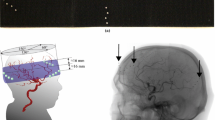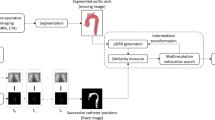Abstract
Purpose
Image guidance for minimally invasive surgery is based on spatial co-registration and fusion of 3D pre-interventional images and treatment plans with the 2D live intra-interventional images. The spatial co-registration or 3D–2D registration is the key enabling technology; however, the performance of state-of-the-art automated methods is rather unclear as they have not been assessed under the same test conditions. Herein we perform a quantitative and comparative evaluation of ten state-of-the-art methods for 3D–2D registration on a public dataset of clinical angiograms.
Methods
Image database consisted of 3D and 2D angiograms of 25 patients undergoing treatment for cerebral aneurysms or arteriovenous malformations. On each of the datasets, highly accurate “gold-standard” registrations of 3D and 2D images were established based on patient-attached fiducial markers. The database was used to rigorously evaluate ten state-of-the-art 3D–2D registration methods, namely two intensity-, two gradient-, three feature-based and three hybrid methods, both for registration of 3D pre-interventional image to monoplane or biplane 2D images.
Results
Intensity-based methods were most accurate in all tests (0.3 mm). One of the hybrid methods was most robust with 98.75% of successful registrations (SR) and capture range of 18 mm for registrations of 3D to biplane 2D angiograms. In general, registration accuracy was similar whether registration of 3D image was performed onto mono- or biplanar 2D images; however, the SR was substantially lower in case of 3D to monoplane 2D registration. Two feature-based and two hybrid methods had clinically feasible execution times in the order of a second.
Conclusions
Performance of methods seems to fall below expectations in terms of robustness in case of registration of 3D to monoplane 2D images, while translation into clinical image guidance systems seems readily feasible for methods that perform registration of the 3D pre-interventional image onto biplanar intra-interventional 2D images.





Similar content being viewed by others
References
Rudin S, Bednarek DR, Hoffmann KR (2008) Endovascular image-guided interventions (EIGIs). Med Phys 35(1):301
Ruijters D, Homan R, Mielekamp P, van de Haar P, Babic D (2011) Validation of 3D multimodality roadmapping in interventional neuroradiology. Phys Med Biol 56(16):5335–5354
Jannin P, Krupinski E, Warfield S (2006) Validation in medical image processing. IEEE Trans Med Imaging 25(11):1405–1409
Jannin P, Grova C, Maurer CR (2006) Model for defining and reporting reference-based validation protocols in medical image processing. Int J Comput Assist Radiol Surg 1(2):63–73
Mitrović U, Špiclin Ž, Likar B, Pernus F (2013) 3D–2D registration of cerebral angiograms: a method and evaluation on clinical images. IEEE Trans Med Imag 32(8):1550–1563
Markelj P, Likar B, Pernuš F (2010) Standardized evaluation methodology for 3D/2D registration based on the visible human data set. Med Phys 37(9):4643–4647
van de Kraats E, Penney G, Tomaževič D, van Walsum T, Niessen W (2005) Standardized evaluation methodology for 2-D–3-D registration. IEEE Trans Med Imaging 24(9):1177–1189
Markelj P, Tomaževič D, Likar B, Pernuš F (2012) A review of 3D/2D registration methods for image-guided interventions. Med Image Anal 16(3):642–661
Groher M, Zikic D, Navab N (2009) Deformable 2D–3D registration of vascular structures in a one view scenario. IEEE Trans Med Imaging 28(6):847–860
Hipwell JH et al (2003) Intensity-based 2-D–3-D registration of cerebral angiograms. IEEE Trans Med Imaging 22(11):1417–1426
Kerrien E, Berger M-O, Maurincomme E, Launay L, Vaillant R, Picard L (1999) Fully automatic 3D/2D subtracted angiography registration. In: Medical image computing and computer-assisted intervention—MICCAI 1999. Springer, London, pp 664–671
Feldmar J, Ayache N, Betting F (1997) 3D–2D projective registration of free-form curves and surfaces. Comput Vis Image Und 65(3):403–424
Groher M, Jakobs TF, Padoy N, Navab N (2007) Planning and intraoperative visualization of liver catheterizations: new CTA protocol and 2D–3D registration method. Acad Radiol 14(11):1325–1340
Groher M, Bender F, Hoffmann R-T, Navab N (2007) Segmentation-driven 2D–3D registration for abdominal catheter interventions. In: Medical image computing and computer-assisted intervention—MICCAI, 2007, vol 10. Springer, Berlin, pp 527–535
Kita Y, Wilson DL, Noble A (1998) Real-time registration of 3D cerebral vessels to X-ray angiograms. In: Medical image computing and computer-assisted interventation—MICCAI 1998, vol 1496. Springer, Berlin, pp 1125–1133
Rivest-Hénault D, Sundar H, Cheriet M (2012) Nonrigid 2D/3D registration of coronary artery models with live fluoroscopy for guidance of cardiac interventions. IEEE Trans Med Imaging 31(8):1557–1572
Tomaževič D, Likar B, Slivnik T, Pernuš F (2003) 3-D/2-D registration of CT and MR to X-ray images. IEEE Trans Med Imaging 22(11):1407–1416
Markelj P, Tomaževič D, Pernuš F, Likar B (2008) Robust gradient-based 3-D/2-D registration of CT and MR to X-ray images. IEEE Trans Med Imaging 27(12):1704–1714
Livyatan H, Yaniv Z, Joskowicz L (2003) Gradient-based 2-D/3-D rigid registration of fluoroscopic X-ray to CT. IEEE Trans Med Imaging 22(11):1395–1406
Chan HM, Chung ACS, Yu SCH, Wells WM III (2004) 2D–3D vascular registration between digital subtraction angiographic (DSA) and magnetic resonance angiographic (MRA) images. Presented at the IEEE international symposium on biomedical imaging: nano to macro, vol 1, pp 708–711
Turgeon G-A, Lehmann G, Guiraudon G, Drangova M, Holdsworth D, Peters T (2005) 2D–3D registration of coronary angiograms for cardiac procedure planning and guidance. Med Phys 32(12):3737–3749
Vermandel M, Betrouni N, Gauvrit J-Y, Pasquier D, Vasseur C, Rousseau J (2006) Intrinsic 2D/3D registration based on a hybrid approach: use in the radiosurgical imaging process. Cell Mol Biol 52(6):44–53
Jomier J, Bullitt E, Van Horn M, Pathak C, Aylward SR (2006) 3D, 2D model-to-image registration applied to TIPS surgery. In: Medical image computing and computer-assisted intervention—MICCAI 2006, vol 9. Springer, Berlin, pp 662–669
Ruijters D, ter Haar Romeny BM, Suetens P (2009) Vesselness-based 2D–3D registration of the coronary arteries. Int J Comput Assist Radiol Surg 4(4):391–397
Metz C et al (2013) Registration of 3D+t coronary CTA and monoplane 2D+t X-ray angiography. IEEE Trans Med Imaging 32(5):919–931
Copeland AD, Mangoubi RS, Desai MN, Mitter SK, Malek AM (2010) Spatio-temporal data fusion for 3D+T image reconstruction in cerebral angiography. IEEE Trans Med Imaging 29(6):1238–1251
Powell MJD (1964) An efficient method for finding the minimum of a function of several variables without calculating derivatives. Comput J 7(2):155–162
Madan H, Pernuš F, Likar B, Špiclin Ž (2017) A framework for automatic creation of gold-standard rigid 3D–2D registration datasets. Int J CARS 12(2):263–275
Mitrović U, Pernuš F, Likar B, Špiclin Ž (2015) Simultaneous 3D–2D image registration and C-arm calibration: application to endovascular image-guided interventions. Med Phys 42(11):6433–6447
Hansen N (2012) The CMA evolution strategy: a comparing review. In: Lozano JA, Larrañaga P, Inza I, Bengoetxea E, (eds) Springer, Berlin pp 75–102
Funding
This research was supported by the Slovenian Research Agency (Grants Nos. P2-0232, J2-5473, J7-6781, J2-7211 and J2-8173).
Author information
Authors and Affiliations
Corresponding author
Ethics declarations
Conflict of interest
The authors declare that they have no conflict of interest related to this research work.
Ethical standard
For this type of study, formal consent is not required.
Rights and permissions
About this article
Cite this article
Mitrović, U., Likar, B., Pernuš, F. et al. 3D–2D registration in endovascular image-guided surgery: evaluation of state-of-the-art methods on cerebral angiograms. Int J CARS 13, 193–202 (2018). https://doi.org/10.1007/s11548-017-1678-2
Received:
Accepted:
Published:
Issue Date:
DOI: https://doi.org/10.1007/s11548-017-1678-2




